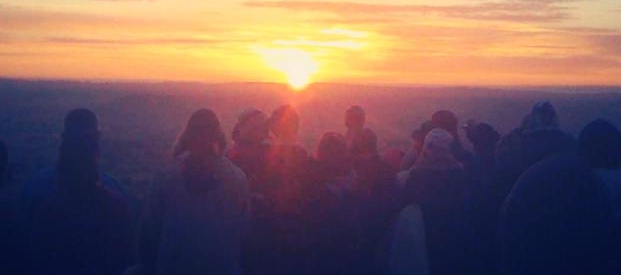Summer Solstice
Since ancient times, people all over the world have celebrated the summer solstice. Early civilisations built temples to align with the sunrise, others enjoyed festivals and ceremonies. Today, 5,000 years on, it’s still a time of spirituality mixed with midsummer fun.
The longest day
The summer solstice is an astronomical event and falls on or near 21 June each year. The word solstice means ‘sun stands still’, coming from the Latin words ‘sol’ (sun) and ‘sistere’ (to stand still) as the sun appears to halt in its journey across the sky and change little in position during this time.
Here’s the astronomy: as the Earth travels around the sun, the position of the sun changes over the course of the year because of the changing orientation of the Earth’s tilted axis. The summer and winter solstices occur at the times when the Earth’s equator is most tilted, when the sun is at its greatest angle to the equator. The sun is higher in the sky in the summer months and lower in the winter. The summer solstice is the time when the sun appears at its highest in the sky at noon. It’s the longest day of the year.
Ancient temples, festivals and rituals
Mayans, Aztecs, Egyptians and other ancient civilisations, built structures which aligned with the summer solstice. Others celebrated with festivals and rituals.
Ancient Britons constructed Stonehenge, aligning the massive Heel Stones and the ‘avenue’ so that the sun rose between the two Heel Stones and penetrated to the altar stone at the centre of the henge. In the north of Scotland, the people of Neolithic Orkney set the stones of the Ring of Brodgar to align with notches in the hills at the time of sunrises and sunsets at the solstices.
In Greece, according to some early versions of the calendar, the summer solstice was the first day of the year and a time of several festivals including Kronia, celebrating Cronus, god of agriculture. It also marked the one-month countdown to the Olympic games. Rome honoured Vesta – goddess of the hearth – with the Vestalia festival, and this was the only time of the year when married women could enter the sacred temple of the vestal virgins to make offerings. In China, the summer solstice was a time to honour the earth, femininity and the force known as yin, while in contrast, the winter solstice was dedicated to the heavens, masculinity and yang.
Northern and central European tribes lit bonfires to signify the triumph of light over darkness and give thanks to the sun god. Some practiced a ritual in which couples would jump through the flames to predict how high that year’s crop would grow. Others harvested certain ‘sun’ plants including golden marigold and St John’s wort which, when gathered on the shortest night, were said to take on properties that they wouldn’t have if picked at any other time.
Native Americans decorated their bodies in symbolic colours and celebrated the longest day with rituals including a Sun Dance around a tree, felled and then raised as a link between the Earth and the heavens.
With the rise of Christianity the festivities continued but centred around 24 June, St John the Baptist’s Day, honouring St John instead of the pagan gods. 24 June is also Midsummer Day, and in the UK calendar it is one of the four Quarter Days, which are – perhaps confusingly – considered to be the start of the each of the four seasons.
Solstice 2014: festivals and events
Across the world this June, people in many countries will celebrate the summer solstice, nowhere more so than in Sweden, where ‘Midsommar’ is a time to welcome the long summer days, to be thankful for the fertility of Earth, and to head for the countryside for a holiday. Across Scandinavia, people decorate their houses with flower garlands and tree branches, and friends meet to eat and drink. Bonfires burn on the lakes and beaches, dancers swirl around the midsummer pole, and young women put flowers under their pillows to induce dreams of future husbands.
Throughout the UK a wide range of events marks the occasion: the dawn ceremony with poetry and music at the Neolithic Ring of Brodgar on Orkney; bonfires and fireworks in Cornwall; and in Suffolk, a sunset walk among the royal burial mounds at Anglo-Saxon Sutton Hoo. The ritual burning of the wicker man is re-enacted at Kentwell Hall’s Tudor Midsummer Weekend, and there’s music and dance and a bonfire too.
Bath’s Midsummer Night Ball is a glamorous occasion with a torch-lit drinks reception and dancing at the Roman Baths, while in Bedfordshire, Woburn Abbey’s Garden Party hosts a summer picnic in the fine grounds surrounding the historic house. In Edinburgh, a host of tree-enthusiasts will meet at the Royal Botanic Garden where, accompanied by live music and poetry, they will attempt to break the world record for tree hugging.
And of course, one of the most famous solstice celebrations anywhere, takes place within the impressive stone circle of England’s Stonehenge. It is the one day of the year when it’s possible to walk among the huge standing stones – usually visitors must view them from around the perimeter. Some 20,000 people will gather here, some simply to see the sun rise, others for the spiritual experience, some dressed in flowing robes to join in pagan ceremonies.
Once a year at sunrise, here at the mysterious monument of Stonehenge, the solstice forms a strange link between the ancients and the world of today.
Image Credit: Patrick Hasler










